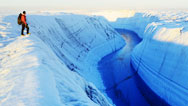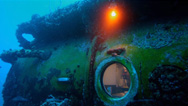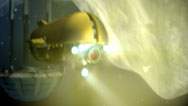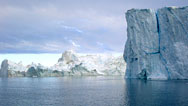Waging Science on the High Seas
- By Ari Daniel
- Posted 08.27.15
- NOVA
Doing science at sea means you don’t mind having the odds stacked against you. Bad weather, saltwater, and giant icebergs can shred, corrode, and pulverize oceanographic equipment—not to mention wear down the oceanographers themselves. But in exchange for that perseverance is the possibility of glimpsing into the waters that bathe and sustain our planet.
Transcript
Mattias: There’s something about just being in the environment, and seeing the region you’re sampling that’s really mesmerizing in a way. You can discuss with other scientists in real-time at sea what the observations mean. And I think you have more of a rapport with the data that you collect as a scientist when you actually see where it’s coming from and how it’s collected.
Magdalena: If you’re not in the field making the measurements, you’re not actually seeing what the real ocean is really doing. When you go through the effort to put an instrument into the water and get it out, and saw the struggle that went into it, you—when you go home—have a different relationship to that data.
Will: You can’t just walk on a ship and expect everything’s just like being on land. Cause it’s not, at all. The difference from working ashore is that it’s an ever-changing weather environment. You think you’re all safe, but if the ship sinks, you’re not so safe anymore. There’s always that underlying risk.
Becca: Everything is different than how you might do it elsewhere—just trying to make things work with what you have. So it’s a funny pace of always being busy but it’s also a fun opportunity to really get to know all the people you’re on the ship with. You have all your meals together, you work 16 hours a day together. You share bunk rooms. Cause it is just a totally different pace than everyday life.
Nat: I like how beyond everyday experience these places look. This place, for example—it’s covered in small glaciers. There are no trees, it’s all rock. There are all these amazing places around the world that you don’t get to see very often.
Nick: The most immediate thing you feel is the simplicity and isolation. Like you’re in your own little world exploring things, which is, I think, really fun. You only have pretty clear tasks during the day—you get up, you eat, you figure out where you’re gonna sample, you sample, you eat again. It’s pretty straightforward what your day is like. You feel a quiet you don’t feel other places, I think.
Credits
PRODUCTION CREDITS
- Featuring, in order of appearance
- Mattias Cape, Woods Hole Oceanographic Institution
Magdalena Andres, Woods Hole Oceanographic Institution
Will Ostrom, Cape Cod Anchorage
Rebecca Jackson, Woods Hole Oceanographic Institution
Nat Wilson, Woods Hole Oceanographic Institution
Nick Beaird, Woods Hole Oceanographic Institution - Videography & Production
- Ari Daniel
- This research was funded by:
- the National Science Foundation
- Financial support for reporting provided by:
- the Pulitzer Center on Crisis Reporting
- Original Footage
- © WGBH Educational Foundation 2015
MEDIA CREDITS
- Music
- APM
IMAGE
- (Main image: Ocean sampling)
- Ari Daniel
Related Links
-

Extreme Ice
An acclaimed photographer teams up with scientists to document the runaway melting of arctic glaciers.
-

Two Weeks Under the Sea
Aquanauts study the health of marine organisms—by becoming their neighbors.
-

Mystery of the Gakkel Ridge
Scientists journeying deep beneath Arctic sea ice discover a world never before seen.
-

Fastest Glacier
A glacier moving way too fast reveals how unpredictable the effects of global warming can be.

